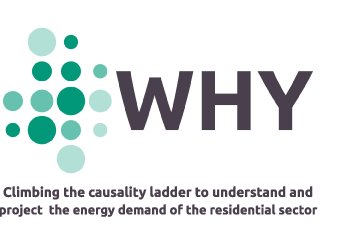Use Case Simulation Methodology
Deliverable 5.2
About this document
This document includes the results of five use cases capturing a wide diversity of contexts from local and energy community to national, European and global level. The goal is to provide an improved and transparent energy modelling framework focusing on the household sector and to address specific questions related to the evolution of the energy consumption at local, national, European, and global levels. The raw data from the five Use Cases of the WHY project can be found online in open access: https://zenodo.org/doi/10.5281/zenodo.7382923. The design of all Use Cases has been greatly benefited from the active engagement of stakeholders and end-users, including policy makers, public authorities, businesses, and utilities. In all cases, stakeholders helped to define the most important aspects, questions, and policy interventions to be assessed in each Use Case from the local up to the European and global ones.
The Positive Energy District Use Case in Maintal aims to assess the impacts of interventions in a positive energy district using the WHY Toolkit. The goal is to inform policy decisions (and energy system planning) related to energy consumption, fuel mix, technology investment, energy costs and CO2 emissions at the local level in case of blackout. The WHY Toolkit was applied to simulate 131 households applying 3 different archetypes (Single Family Home, Detached and Terraced Home and Apartment Building). This involved utilizing the toolkit’s capabilities to model and analyse different scenarios, considering factors such as energy demand, water consumption as well as electrical and thermal load profiles, the so-called inner heat gains, renewable energy generation and potential policy measures. Stakeholder engagement is integral to refining the Use Case and validating the methodology. The Maintal use Case showcased the practical application of the WHY Toolkit in a local setting and its results contributed to the understanding of how interventions can shape energy outcomes at the community level.
The Energy Cooperative Use Case demonstrated the WHY Toolkit’s efficacy in understanding and influencing residential energy consumption behavior tested in an energy cooperative. Goiner, a non-profit citizen energy cooperative in the Basque country, used the WHY Toolkit to simulate residential consumers’ behaviour. Goiner aimed to understand how changes in its tariff structure would impact load profiles, purchasing strategies, and long-term goals, such as reducing energy consumption and alleviating energy poverty. The findings of the analysis showed that behavioural changes such as load shifting, and energy reduction actions are influenced by tariff complexity and perceived barriers.
The Energy Community Use Case explores the role of local and citizen led engagement in clean energy transition. Specifically, this use case showcases how new energy community-based business models can contribute to making cities climate neutral by 2030. In this direction, the study employs a comprehensive methodology combining survey results from community partners and stakeholders. The study evaluates key drivers such as the state of play, business models, value sharing governance structures, replicability, scalability, and future projections. This use case provides a comprehensive understanding of the energy community landscape, emphasizing the diverse structures, services, financial tools, and challenges faced and how the WHY toolkit can be used to address them.
The European Use Case delves into the impact of energy and climate policies on achieving EU goals for climate change mitigation and energy efficiency. By soft-linking the PRIMES-BuiMo buildings model with the WHY Toolkit, this use case explores the role of energy consumers in decarbonizing European buildings. The soft-linking bridges the gap between cost-optimality in Energy System Models (ESMs) and the dynamics of everyday behavioral decisions by energy consumers. The model-based analysis shows that the EU’s transition towards climate neutrality required significant investment in energy efficiency of buildings combined with decarbonization of the fuel mix, mostly through the uptake of electric heat pumps replacing the use of fossil fuels. The Use Case also demonstrates that targeted policy interventions considering the national context and specificities are required to ensure an efficient and sustainable transition to zero-emission buildings.
The Global Use Case explores the implications of ambitious climate policies and energy efficiency measures on the global energy mix, with a specific focus on the future development of the buildings sector. Employing two well established Integrated Assessment Models TIAM-ECN and PROMETHEUS, linked with the WHY Toolkit, this use case aim to enhance the model simulation properties for a more accurate representation of decarbonization in the buildings sector. The overarching goal is to bring a global perspective to the project, demonstrating how tools developed in WHY can benefit global energy and climate modelling studies. The Global Use Case provides essential insights into the potential risks and complexities associated with specific policy measures for the buildings sector emphasizing the need for comprehensive analysis and informed decision making in the pursuit of global decarbonization goals.




